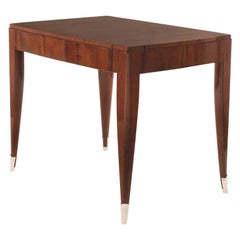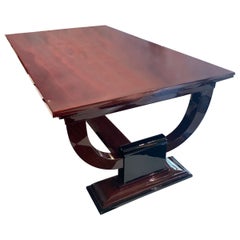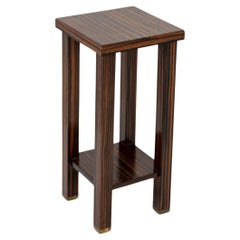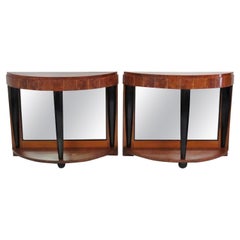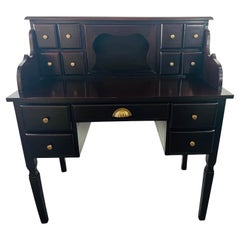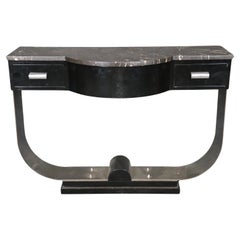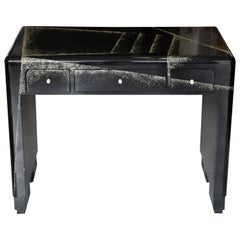Émile-Jacques Ruhlmann Tables
Endeavoring to create exquisite work that would endure forever, designer Émile-Jacques Ruhlmann defined the grandeur of the French Art Deco movement of the 1920s. His luxurious storage cabinets, seating, other furniture and interiors garnered considerable popularity alongside the growth in post–World War I Paris’s population of newly wealthy residents.
The Paris-born Ruhlmann was the son of a decorating contractor, a business he took over in the early 1900s and expanded into furniture and interior design. But by the end of his career, he was best known for being a skilled ensemblier, a term for a designer who not only makes furniture and decorates spaces but rather personally crafts each and every piece required in the space, from doorknobs to sofas. This practice ensured that the space was harmonious and consistent with Ruhlmann’s vision, and it contributed to the lasting popularity of his designs.
Ruhlmann enjoyed the patronage of the newly affluent and was encouraged by the popularity of Art Deco. While the Arts and Crafts and Art Nouveau movements were early influences, he is renowned for the modernity of his Art Deco–era designs, which reflected the celebratory nature of the times, including an integration of opulent flourishes; luxurious materials like Macassar ebony, amboyna burl, ivory and precious metals; and skilled craftsmanship and construction techniques.
Renowned all over the world, Ruhlmann was commissioned by the Metropolitan Museum of Art in New York to design a cabinet in 1925, embellishing its curved door with a sophisticated floral motif by way of an ornate marriage of wood and ivory veneer. Also in 1925, at the Exposition Internationale des Arts Décoratifs et Industriels Modernes, arguably the exhibition that introduced Art Deco on an international level, his pavilion was the most popular.
By the time the economic depression of the 1930s materialized, Ruhlmann’s exorbitantly expensive designs were no longer viable. But the majesty and elegance of the ’20s remain an important part of design history, and Ruhlmann has been described as “perhaps its finest exponent.”
Find a collection of authentic Émile-Jacques Ruhlmann furniture on 1stDibs.
20th Century French Art Deco Émile-Jacques Ruhlmann Tables
Bronze
1930s French Art Deco Vintage Émile-Jacques Ruhlmann Tables
Purpleheart
Mid-20th Century Italian Art Deco Émile-Jacques Ruhlmann Tables
Brass
20th Century French Mid-Century Modern Émile-Jacques Ruhlmann Tables
Mirror, Wood, Walnut, Burl
Late 20th Century American Classical Émile-Jacques Ruhlmann Tables
Mahogany
1950s French Art Deco Vintage Émile-Jacques Ruhlmann Tables
Marble, Steel
1930s French Art Deco Vintage Émile-Jacques Ruhlmann Tables
Bronze
1930s Italian Art Deco Vintage Émile-Jacques Ruhlmann Tables
Walnut
1920s Czech Art Deco Vintage Émile-Jacques Ruhlmann Tables
Wood
21st Century and Contemporary British Georgian Émile-Jacques Ruhlmann Tables
Walnut, Boxwood, Olive, Satinwood
1920s German Art Deco Vintage Émile-Jacques Ruhlmann Tables
Walnut
21st Century and Contemporary Italian Modern Émile-Jacques Ruhlmann Tables
Metal, Stainless Steel
Mid-20th Century Italian Mid-Century Modern Émile-Jacques Ruhlmann Tables
Metal
Late 20th Century Art Deco Émile-Jacques Ruhlmann Tables
Wood, Ebony, Macassar
1950s Italian Mid-Century Modern Vintage Émile-Jacques Ruhlmann Tables
Brass
Mid-20th Century Art Deco Émile-Jacques Ruhlmann Tables
Rosewood
1920s French Art Deco Vintage Émile-Jacques Ruhlmann Tables
Wood
1920s French Art Deco Vintage Émile-Jacques Ruhlmann Tables
Macassar
1930s French Art Deco Vintage Émile-Jacques Ruhlmann Tables
Hemp, Oak
1930s French Art Deco Vintage Émile-Jacques Ruhlmann Tables
Oak, Ash
1930s French Art Deco Vintage Émile-Jacques Ruhlmann Tables
Oak, Ash
20th Century French Émile-Jacques Ruhlmann Tables
Wood
Émile-jacques Ruhlmann tables for sale on 1stDibs.
Creators Similar to Émile-Jacques Ruhlmann
- 1stDibs ExpertApril 22, 2024A few things characterized the work of Émile-Jacques Ruhlmann. By the end of his career, he was best known for being a skilled ensemblier, a term for a designer who not only makes furniture and decorates spaces but personally crafts each and every piece required in the space, from doorknobs to sofas. This practice ensured that the space was harmonious and consistent with Ruhlmann’s vision, and it contributed to the lasting popularity of his designs. While the Arts and Crafts and Art Nouveau movements were early influences, he is renowned for the modernity of his Art Deco designs, which reflected the opulent nature of the era, involving luxurious materials like Macassar ebony, amboyna burl, ivory and precious metals and skilled craftsmanship and construction techniques. Explore a variety of Émile-Jacques Ruhlmann furniture on 1stDibs.
